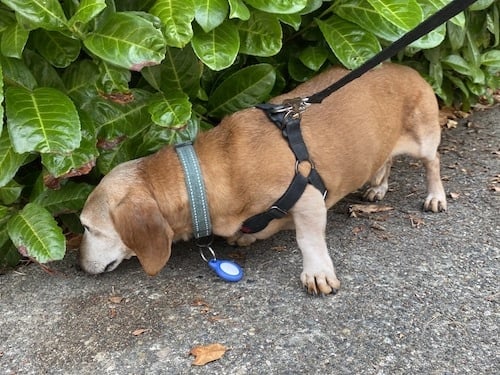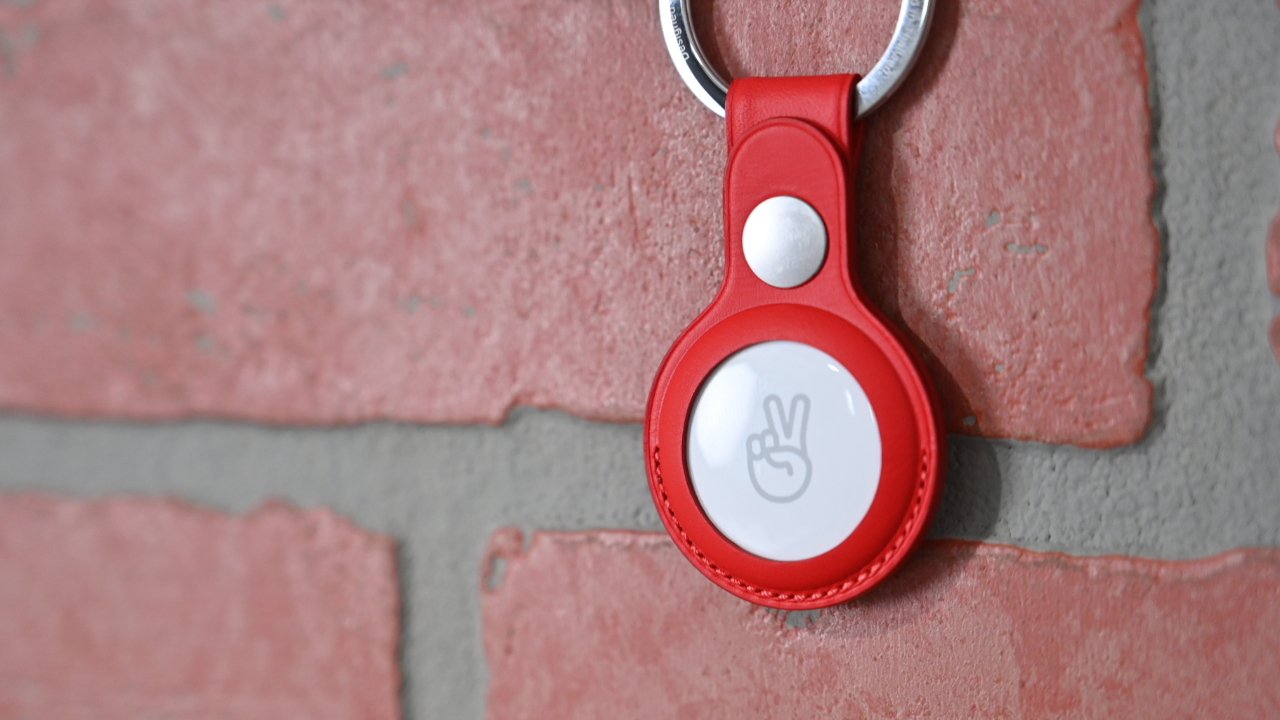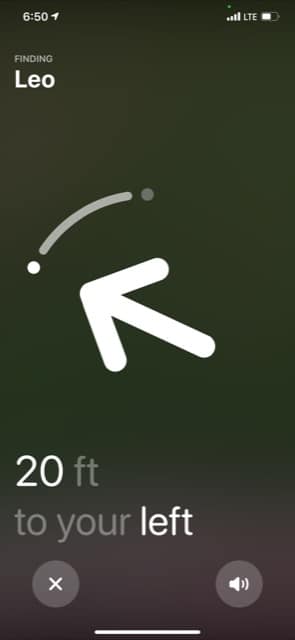Here is another article with pluses and minuses.
How Do Apple AirTags Work for Dogs?
Apple AirTags are tiles designed to be clipped to backpacks, slipped in wallets, or added to keychains to make those objects instantly discoverable on a map in your Apple Find My app. They’re small enough and and lightweight enough to be worn on most dogs’ collars.
An AirTag has two ways of helping you find a lost dog. First, there’s Bluetooth. When you’re close to the tag, you can turn on a compass feature that points you to it. You can even “ping” the AirTag, causing its built-in speakers to make a sound that helps you track it down.
The Bluetooth finding feature that lets you locate your nearby AirTag.
To find a dog who’s out of Bluetooth range, you’ll use “Lost Mode.” Once you turn Lost Mode on, you’ll receive a notification any time the AirTag (and your dog) enters the Bluetooth range of any iPhone with cell service—any iPhone in the world.
The app will send you the address where your AirTag was spotted, and you can even alter your settings so that the phone that came into contact with your AirTag receives a message with instructions from you.
For pet parents, it’s an ideal feature. Not only can you get to your dog yourself, you can even personally contact the person who found your pup to ask that they hold him there for you.
Our favorite Italian Greyhounds Figgy and Leo (and their amazing parent Mary Vargas) demonstrate Lost Mode.
The AirTag doesn’t need daily or weekly charging—its battery is typically good for about a year, and it’s user-replaceable. All you have to do is register the AirTag as yours and clip it to your dog’s collar.
Apple AirTags VS Dog GPS Devices
Overall, the
Apple AirTag has some stellar qualities that rival even the
best GPS trackers for dogs on the market—and at a far lower price point. But it also has critical weaknesses that may make it unsuitable for some pet parents, like its limited ability to track a pet lost in unpopulated areas.
We tried out the Apple AirTag on several pups, including Miniature Dachshund Oscar and Italian Greyhounds
Figgy and Leo. Here’s what’s good, what’s bad, and what to know before you buy.
Pros of using an Apple AirTag for dogs
- Low price. Unlike most dog GPS devices, which tend to sell for between $50 and $100 and require a monthly subscription, the AirTag costs a flat $29.
- Size. The tile is small and light enough (1.26 inches in diameter and 11 grams) for all but the tiniest dogs. It’s also water resistant.
- Replaceable battery. The AirTag uses a CR2032 coin cell battery that can power an AirTag for a year and will notify you when it’s time to replace. Most dog GPS devices require weekly charging.
- Find your dog yourself. While a microchip leaves you hoping someone else finds and scans your dog, an AirTag sends you an alert any time an iPhone user with service passes in range of your dog.
- Contact the person who finds your dog. Lost Mode lets you offer your contact info and instructions to anyone with an NFC-capable smartphone who taps your dog’s AirTag.
- Proximity tracking within roughly 100 feet. Admittedly, we haven’t yet lost our dogs within Bluetooth range, but this feature did help us find our dogs’ collars after bath time.
- Personalization options. You can get your AirTag personalized so you always know which tag goes with which dog.

Miniature Dachshund Oscar tests out the Apple AirTag
Cons of using an Apple AirTag for dogs
- Lost Mode is dependent on passersby. This is the biggest downside to using an Apple AirTag instead of a true GPS device: if you lose your dog in an area where other iPhones are unlikely to pass within 100 feet, you won’t have any way to track your pup.
- No service, no tracking. If your dog is lost in an area with poor network coverage, you’re unlikely to be able to find them. That said, most dog GPS devices also struggle under these conditions—only radio trackers have an advantage.
- AirTag attachment quality varies. Not all AirTag attachments are suitable for dog collars, which means buyers should exercise caution. That goes double for pet parents worried their dog could swallow a dropped AirTag.
- No notifications when your dog leaves home. Most leading dog GPS brands let you know the minute your dog crosses outside a safe area. An AirTag won’t do that, which can delay your search.
- No health tracking. AirTags don’t monitor your dog’s health, while dog GPS brands increasingly offer Fitbit-like activity tracking. For some, it’s a bell and whistle they don’t need, but for others, it’s a valuable service.
Best AirTag Collars
AirTags weren’t specifically designed for dogs—which means there aren’t any Apple-made collar attachments. Third-party cases are hit or miss.
If you’re using an AirTag on your dog, it’s best to
avoid attachments that:
- Dangle from a loop or key-ring attachment, since these are prone to dragging, snagging, and being pulled off
- Face outward, since these can easily snag or be removed (as Figgy and Leo learned to do)
- Aren’t waterproof or water resistant

Oscar drags his AirTag along using a badly designed key-ring attachment.
Instead,
prioritize AirTag cases that:
- Protect the AirTag from the elements with waterproof or water resistant rubber
- Face inward against your dog’s neck or secure with a clasp to make it hard to snag
- Are attached to a full collar with a safety buckle
You can choose an
AirTag holders that secures the device to your dog’s regular collar (as
Figgy models below). Or you can try a full collar designed to contain an AirTag, like these:
- Furrigo IP68 AirTag Dog Collar. We like the Furrigo because it comes with a waterproof, dustproof compartment that screws the AirTag in for safety. It has reflective stitching and a soft interior, and it’s available in a wide range of sizes.
- Tactical AirTag Dog Collar. The Tactical collar is a heavier-duty model with an emergency-release metal buckle and a handle for control. The AirTag compartment is waterproof, and the collar itself is made from premium nylon.
- CollarDirect AirTag Dog Collar. This sturdy nylon and leather collar secures an AirTag with a one-click snap that hides against your dog’s neck, making it hard to remove without opposable thumbs.

Figgy models an AirTag holder that attaches to a dog’s collar.
Should You Get an AirTag for Your Dog?
It depends on where you live, what kind of dog you have, and how much you want to pay.
For those who live in remote areas or near large tracts of wilderness, the Apple AirTag isn’t a good fit. You can’t count on passersby to find your missing friend. You might try a radio tracker like the
Garmin T5. It’s not as sleek as an AirTag, but it’s also not reliant on a dense population with cellphones at the ready.
Pet parents living with escape artists—the dogs who make bolting off their life’s passion—would also do better with a
true dog GPS device. Good ones will come with live tracking, which means you can see your dog’s location anywhere there’s cell service, no matter how unpopulated the area. The
Tractive is one of the most popular, both for its reasonable device and subscription pricing and its
straightforward design.
For city dwellers who aren’t ready for or interested in a higher price point, however, the AirTag can be a strong security measure. It’s a good middle-ground option between a microchip alone and a traditional GPS device—it offers a degree of peace of mind at a price point that’s hard to beat.
Further Reading
Share







